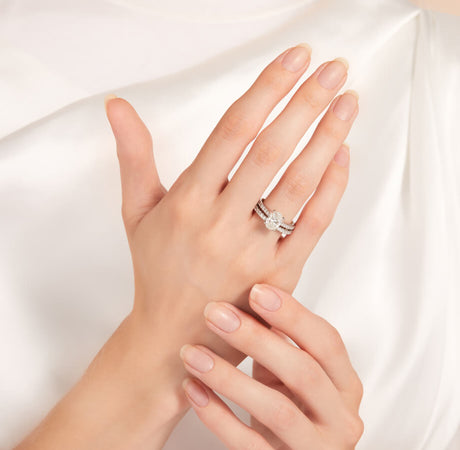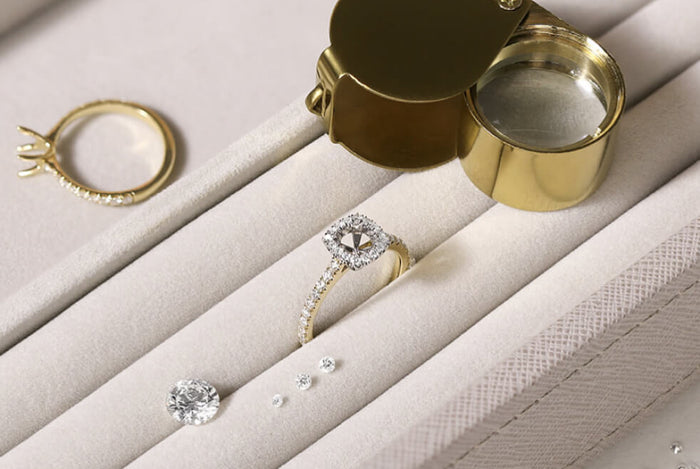When you're shopping for an engagement ring or any piece of fine jewellery, one big decision you'll face is choosing the right metal. White gold and platinum are two of the most popular options, but how do they really compare? Both beautiful and durable, these precious metals each have their own unique characteristics that can make or break your jewellery decision. If you're unsure which one to choose, this guide will help break down the differences, benefits, and considerations.
By the end, you'll have the information you need to make a choice that suits your style, budget, and lifestyle.
What Are White Gold and Platinum?
Before we compare the two, it’s essential to understand what white gold and platinum are.
What is White Gold?
White gold is an alloy, meaning it’s made by mixing gold with other metals like palladium, silver, or nickel to enhance durability and give it that silvery-white colour. Since pure gold (which is naturally yellow) is soft and malleable, these added metals ensure white gold is strong enough for everyday wear. To complete its look, white gold is also coated with rhodium, a shiny and durable material that enhances its reflective finish.
White gold is available in different karats, such as 9k or 18k, which denote the proportion of gold in the alloy. The higher the karat, the more gold it contains—but this also makes it slightly less durable.
What is Platinum?
Platinum, on the other hand, is a naturally white metal. Unlike white gold, it doesn’t require plating to achieve its lustrous appearance. It's one of the rarest elements in the world, making it exclusive and valuable. Platinum used in jewellery is almost always 95% pure, which gives it its high density and strength.
Known for its hypoallergenic properties, platinum is suitable for people with sensitive skin or allergies to certain metals, such as nickel. This makes it an appealing choice for those prioritising comfort along with aesthetics.
Appearance and Aesthetic Differences
One of the first considerations when choosing between white gold and platinum is their appearance, as both have that stunning silvery-white hue. But if they look similar, how can you tell the difference?
White Gold Aesthetic
White gold offers a highly reflective and bright finish thanks to its rhodium plating, giving it a polished, mirror-like shine. However, over time, this plating can wear off, exposing the slightly yellowish tone of the gold underneath. To maintain its brilliant finish, white gold may need re-plating every few years, especially for jewellery worn daily, such as rings.

Platinum Aesthetic
Platinum’s soft white luster offers a more subtle beauty compared to the shinier white gold. It develops a natural patina over time, creating a slightly darker, matte finish that many find appealing for its vintage or antique look. If you prefer a high-polish look, platinum can be re-polished easily to restore its original shine.

Durability and Maintenance
Durability is a core factor when picking a metal for jewellery, especially for items like engagement rings, wedding bands, or bracelets that endure daily wear.
White Gold Durability
White gold is strong and resistant to scratches, thanks to its alloy composition. However, it can lose its rhodium plating over time, especially in high-contact areas. To keep it in top condition, you'll need periodic re-plating, usually every one to three years. This upkeep is essential if you want to maintain its ultra-bright appearance.
Platinum Durability
Platinum is considered more durable than white gold for a few reasons. Firstly, it’s denser, which makes it less prone to bending or breaking. Unlike white gold, when platinum scratches, the metal is displaced rather than lost—so it maintains its weight over time. That said, platinum's natural patina may require occasional polishing if you prefer a shinier look, but there’s no need for re-plating.
Cost Comparison
Budget is often a deciding factor when buying jewellery, so it’s important to consider how the cost of white gold compares to platinum.
White Gold Cost
White gold is typically more affordable than platinum. This is because gold is less dense and more readily available than platinum, reducing manufacturing costs. However, you should factor in the ongoing cost of re-plating, which can add up over time.
Platinum Cost
Platinum tends to be more expensive due to its rarity, weight, and purity. While the upfront cost is higher, many people see it as a long-term investment, as it requires less maintenance and holds its value well.
Hypoallergenic Properties
White Gold Allergies
White gold sometimes includes nickel, which can cause allergic reactions in some people. If you have sensitive skin, you may opt for a piece that uses palladium instead of nickel.
Platinum Hypoallergenic Nature
One of platinum’s standout benefits is that it’s hypoallergenic. Its purity means it's ideal for anyone prone to irritation or allergies from other metals.
Environmental Impact and Sustainability
With more people prioritising ethical and eco-friendly buying decisions, the sustainability of precious metals is worth considering.
White Gold's Environmental Impact
Since white gold is an alloy, its production involves mining multiple metals, including gold, which has significant environmental effects. However, many jewellers are turning to recycled gold to mitigate these impacts.
Platinum's Environmental Impact
Platinum mining also takes a toll on the environment, given the energy-intensive process required to extract this rare metal. Still, its durability and purity mean it tends to last for generations, making it a more sustainable choice over time.
When to Choose White Gold or Platinum
Here’s a quick summary to help you decide which metal better suits your jewellery needs:
Choose White Gold If:
- You’re looking for a more affordable option.
- You prefer a brighter, shinier finish.
- You want a softer lighter metal.
Choose Platinum If:
- You have sensitive skin or metal allergies.
- You want a long-lasting metal that develops a unique patina.
- You’re willing to invest in a more premium material that requires minimal upkeep.
The Verdict on White Gold vs. Platinum
Ultimately, the choice between white gold and platinum comes down to personal preferences, budget, and lifestyle. Both options are beautiful, durable, and full of character. Whether you’re buying an engagement ring, wedding band, or any other piece of fine jewellery, consider what matters most to you—appearance, cost, durability, or maintenance—and choose the metal that resonates with your priorities.
Not sure which metal suits your needs? Visit your local jeweller and try on pieces in white gold and platinum to see how they look and feel on your skin. Deliberating between the two options is part of the exciting process of finding the perfect piece of jewellery.











